Laurel O. Peterson
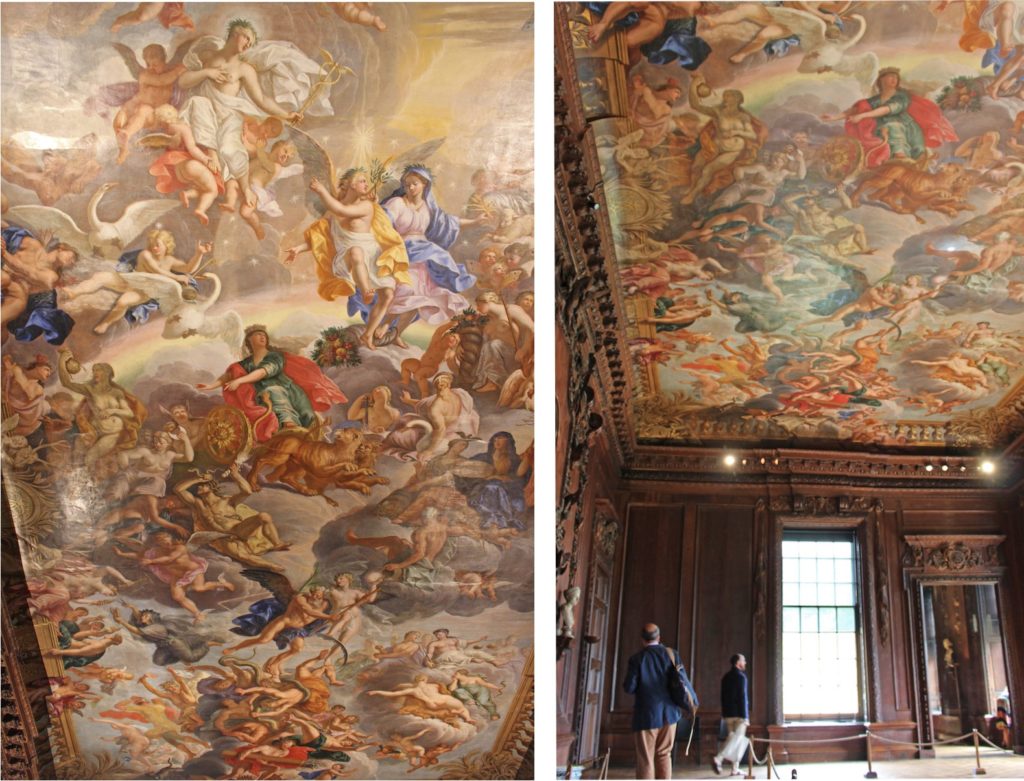
RIGHT: Fig. 2. Great Chamber, 1691-1692. Chatsworth House. Photograph: the author.
A ceiling painting dominates the first room that a visitor encounters on the top floor of Chatsworth house (Fig. 1). The blue sky teems with figures. Towards the top of the composition, a rainbow arcs across the ceiling, and warm golden light from the sun suffuses the sky. The composition centers on Cybele, Earth goddess and Mother of the Gods, clad in rich green and identifiable by her tower crown and lion-drawn chariot. She charts a course between the Vices to her left, and the Virtues to her right, looking upward to figures of Prosperity and Bounty. Above, Virgo, wrapped in white, expresses milk from her breast. The bounty intrinsic to the painted scheme takes more physical form around the room, where limewood carvings of fowl, fish, and flowers, rhythmically punctuate the space (Fig. 2). Festoons of flowers and of shells loop over doorways and windows while fruit and flowers hang in drops on the paneling and carved fowl hang above the chimney piece, as if fresh from the hunt (Fig. 3). Light floods the room from the long south-facing sash windows, making the parquet floors gleam and completing the dramatic aesthetic impact of the space.
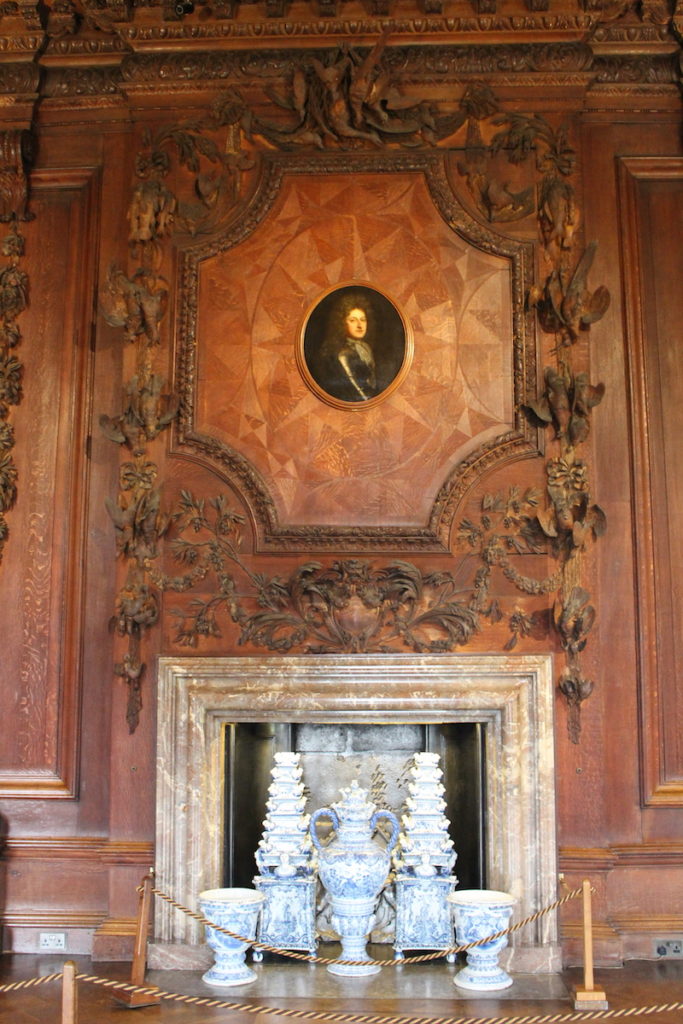
Chatsworth’s Great Chamber has immersed visitors in this sumptuous, dizzying, dramatic interior since the completion of its decoration in 1692. Located deep in the British midlands, more than 150 miles from London, in the heart of the rugged Peak District, such a florid baroque space may come as a surprise to many; the abundant, sun-filled heavens seem more fitting, perhaps, for Italy than for Britain. Indeed, the artist responsible for the ceiling was the Italian-born Antonio Verrio, who began painting this mural in 1691. Yet, somewhat startlingly, a scene of destruction appears at the base of the composition. A red-cloaked figure of Fury appears standing upon symbols of religion and absolutist rule, and putti flee in terror from the bundle of arms he wields (Fig. 4) These surprising symbols distance the mural from Catholic Italy, and signal that the politics of religion are deeply embedded within the scheme.
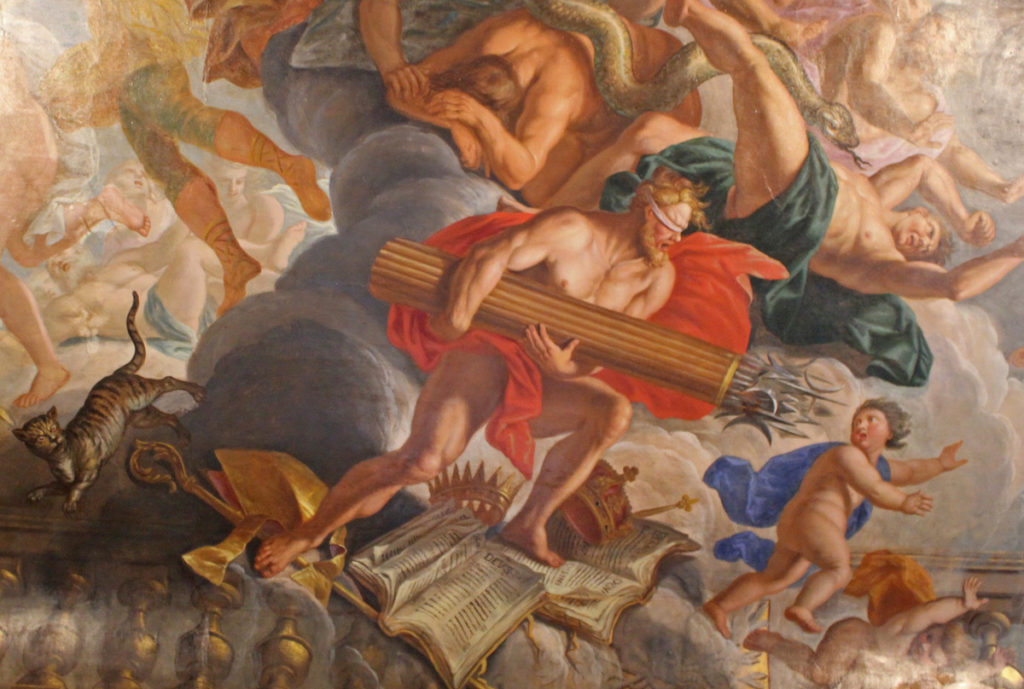
The decoration of the Great Chamber at Chatsworth was carefully designed to further the political and social aims of William Cavendish, fourth earl of Devonshire. In the renovation of his Elizabethan country seat, he employed leading architects, artists, and craftsmen to create a house comparable to a palace in both scale and opulence. These renovations proclaimed his ambitions: though already a member of the peerage as an earl, Devonshire strove for further elevation to the more exalted rank of “duke,” a position that would increase his access to the monarchs and grant his family greater political power—a wish that was finally realized in 1694. Not only did elaborate splendor suggest an elevated rank, but the ceiling’s allegory also contained a powerful political message. In what follows, I will demonstrate how, as a patron, Devonshire mobilized the ceiling’s allegory of the Return of the Golden Age to position himself politically in the wake of the Glorious Revolution of 1688. Significantly, I propose that by highlighting Christian virtue, abundance, and prosperity the scheme specifically honors Queen Mary II, a reading that is reinforced by the relationship of the mural to preceding and subsequent decorations within Chatsworth’s painted interiors. This new interpretation of the Great Chamber’s ceiling not only reveals the ways in which politics infused this mural, but also proposes a hitherto unrecognized importance of the queen to those politics.
Although recent scholarship has turned increasing attention to Mary II and her own role in conjunction with that of her husband, the history of the politics and the visual culture of the Glorious Revolution still predominantly focuses on William III. Indeed, Mary herself had never sought individual rule, and the majority of Mary’s representations focus on her role as a wife or hoped-for mother of a prince.[1] Yet, the ceilings that Devonshire commissioned for his State Apartment indicate that politically, Mary’s influence should be understood as more widespread and significant. Verrio’s Golden Age is not a representation of a royal marriage, where Mary’s role legitimizes her husband’s place on the throne. Rather, on these ceilings, the queen alone is the focus—and indeed in her representation as Cybele, she is positioned as the principal actor within this Golden Age’s return.
Such an interpretation has broader implications, signaling how mural painting was at the vanguard of artistic production in Britain at the end of the seventeenth century. While interiors decorated with allegorical and political messages were standards for palaces in continental Europe—one need only think of the famed Galerie des Glaces (1678-1684) in Louis XIV’s Versailles—they had gained recent popularity in Britain, particularly among the newly powerful Whig elite. Landowners like Devonshire deployed continentally inspired mural paintings to further their own political aims. Despite the popularity of large-scale decorative mural paintings at the turn of the eighteenth century, relatively little attention has been paid to these ambitious works of art since their creation. Scholars such as Richard Johns and Lydia Hamlett have recently begun to shed light on the meaning and the visual experience of these complex schemes, but much work remains to be done to interpret and contextualize the phenomenon of these mural paintings within the history of British art.[2] The implications of the scheme in the Great Chamber signals the ways in which the grand decorative history paintings were shaped by—and, indeed, shaped—the shifting political landscape at the turn of the eighteenth century.
New Spaces, Revolutionary Meaning
Central to Devonshire’s own political identity was the role he played in bringing about the transformative shift in power in 1688 that was hailed almost immediately as a “Glorious Revolution.”[3] Since James II ascended the throne in 1685, many in Britain were anxious about the king’s Catholicism, particularly since his political policies, perceived as deriving from a Catholic absolutist model, seemed to threaten traditional English liberties.[4] The issue of James’s Catholicism came to a crisis point in June 1688, when his queen, Mary of Modena, gave birth to a son and Catholic heir to the throne, realizing fears of a Catholic succession. Devonshire was one of the “Immortal Seven,” a group of six aristocrats and one bishop who, later that summer, invited the Protestant Prince William of Orange to force James from the throne. When William landed on the coast of Torbay on November 5, 1688, Devonshire rode across the countryside building up forces in support of the prince. In 1689, Parliament offered the crown jointly to William and his wife Mary, James’s Protestant daughter. This dramatic course of events forever altered Britain’s political landscape, resulting in sustained changes to political economy, foreign policy, and the very nature of government. As historian Steve Pincus has persuasively argued, by altering the line of succession, the revolutionaries “created a new kind of modern state.”[5] Power became less concentrated in the monarch and shifted outward to the landed elite, as Parliament moderated, balanced, and funded the authority of the king or queen. This shift from absolute monarchy to a functional oligarchy solidified and strengthened the power and influence of elite Whig landholders like Devonshire. It also helped define the Whig political agenda, which valued Protestant rule, an emphasis on manufacture as a means to wealth, the glorification of war, the rejection of absolute monarchy, and the limitation of royal power, which the Whigs saw as the triumph of liberty over tyranny.
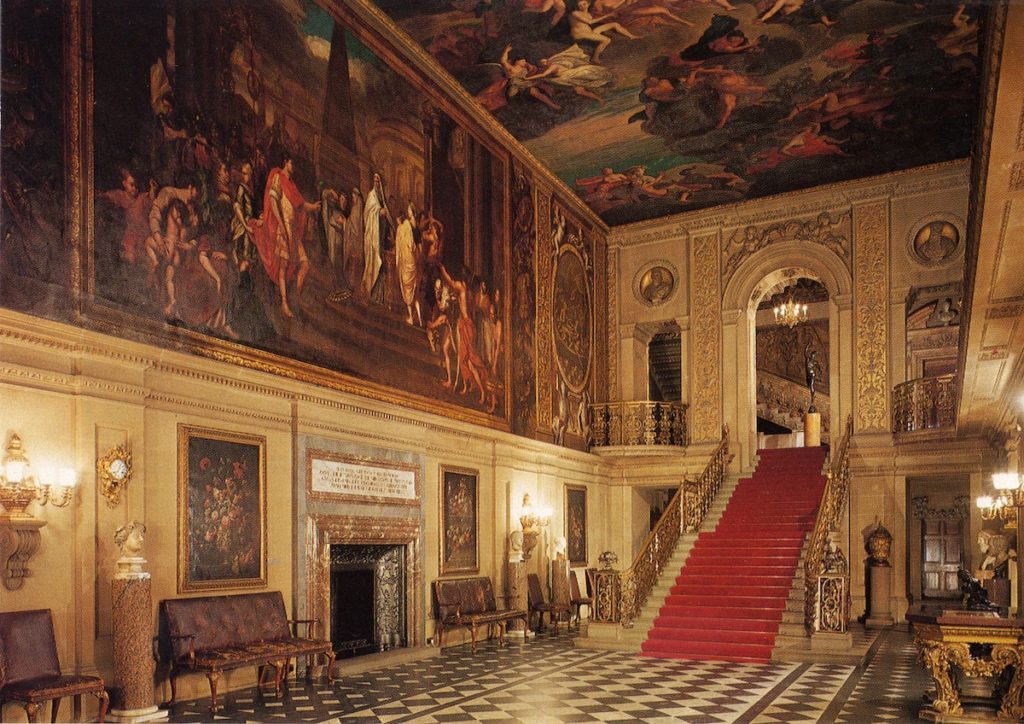
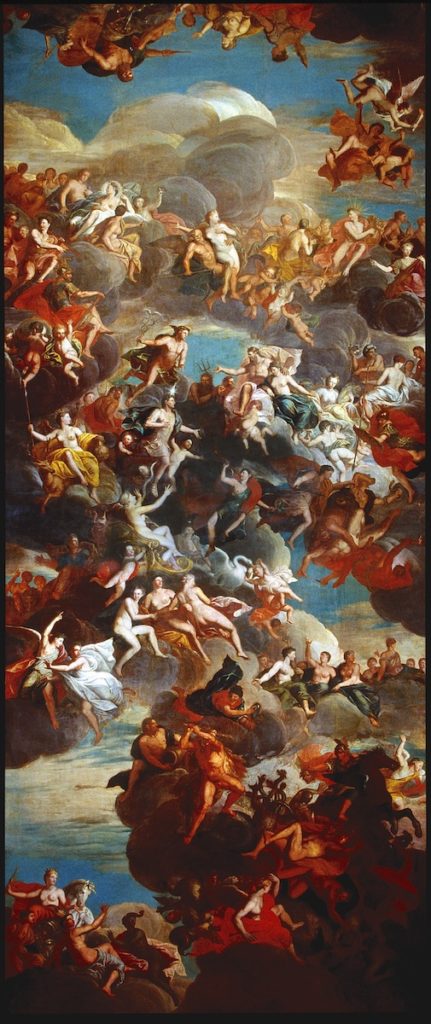
As elite Whigs gained political strength, they expressed their newfound power through innovative architectural patronage, transforming their country houses inside and out. Patrons such as the Marlboroughs at Blenheim or the third earl of Carlisle at Castle Howard made emphatic aesthetic statements in architecture that reflected or implied their social, political, and cultural power. Chatsworth has long been recognized as being at the forefront of such Whig innovation. In an influential article of 1959, John Summerson argued that Chatsworth’s continentally inspired exterior with its classicized facade “inaugurates an artistic revolution which is the counterpart of the political revolution in which [Devonshire] was so prominent a leader,” and described the house as “the first flaunting symbol in architecture of territorial Whiggery.”[6] Although Summerson focused on external architectural style at Chatsworth, Whig political ideology particularly informed and intertwined with its decorated interiors. Devonshire created a series of spaces, culminating in a five-room State Apartment, that was designed to glorify his own politics.
For a visitor to Chatsworth, those politics are apparent soon after entering the house, stepping into the grand Painted Hall (Fig. 5). There, murals produced by the French-born Louis Laguerre between 1692 and 1694 overwhelm any viewer; dozens of figures are arrayed across the ceiling, producing a dizzying display of flesh and floating drapery. The figure of Julius Caesar, marked by the gleaming white star above his head, attracts the attention of the panoply of gods and goddesses who fill the heavens (Fig. 6). Panning around the room, we find that the entire space tells the story of Caesar. On the east wall, an illusionistic easel painting of the emperor sacrificing at a temple is flanked with bas-reliefs of his conquests. The room is more than a biography of Caesar. The entirety of the space juxtaposes the real and the represented, toying with the viewer’s perceptions. The triumphal arch at the top of the stairs, complete with carved bust sculptures, frames a processional entrance to the Grand Staircase just beyond, whereas the opposite wall presents an illusionistic mirror image of the architecture, rendered in paint, best seen after ascending the stairs (Fig. 7).
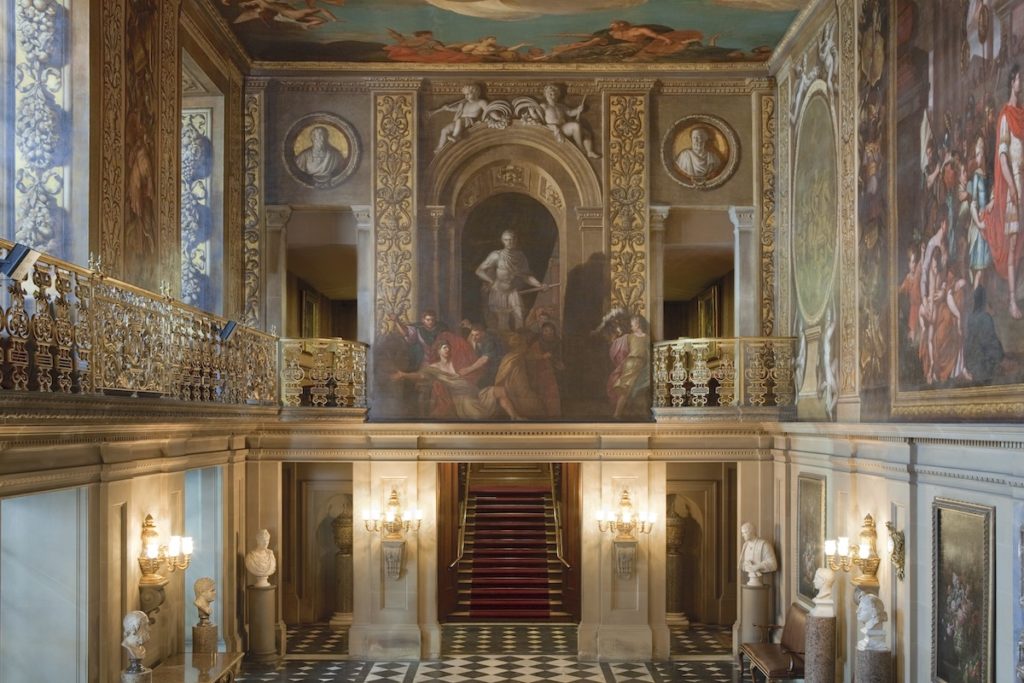
The aesthetic double-take that visitors experience with these two arches is as much political as it is aesthetic, as Richard Johns has demonstrated in his analysis of the revolutionary politics of this space. When we ascend the first set of stairs and look across the room, a painted scene of murder comes into view (Fig. 8). Startlingly, underneath the fictive painted arch, Caesar himself has fallen victim to the lifted daggers of Brutus and his soldiers, before a statue of Pompey. He dies as the result of his abuse of power. As Johns has noted, this scene was not included in the initial plans for the space, and was perhaps added to send a more complex political message.[7] To Devonshire’s contemporaries, Caesar would have been familiar as a symbol of the Stuart kings. King James II’s immediate predecessor, Charles II, regularly styled himself all’ antica, particularly in statuary, as in Grinling Gibbons’s marble statue for the Royal Exchange (Royal Collection).[8] There, the pedestal inscribed “CAROLO II CAESARI Britanico” linked the king to an uninterrupted line of Caesars, one that would continue following the accession of his brother James II.[9] It seems that at Chatsworth, the inclusion of Caesar was not a straightforward glorification, but rather signaled the dismantling of a myth. The Painted Hall becomes a chilling reflection on the dangers of tyrannical absolutism, suggesting how unjust government leads to downfall.[10]
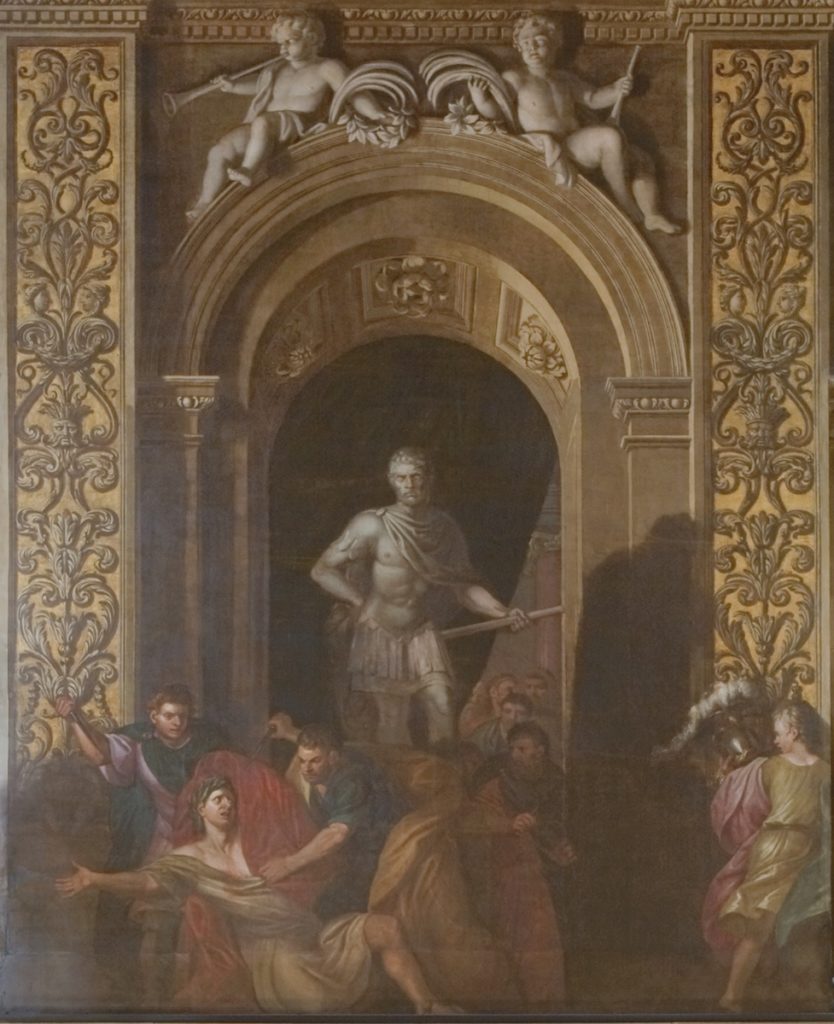
This imagery chimed with Devonshire’s own political ideology. At the time of the Revolution, Devonshire had made a strong statement against tyranny, proclaiming: “We own it Rebellion to resist a King that governs by Law; but he was always accounted a Tyrant, that made his Will the Law; and to resist such a One, we justly esteem no Rebellion, but a necessary Defense.”[11] Devonshire’s words take visual, allegorical form in his Painted Hall, where a tyrant is brought to judgment. Those able to interpret the scheme would have been primed for further political representations throughout the house, responding to contemporary events and in dialogue with contemporary politics rather than simply a glorification of the owner.
Queen Mary, Cybele, and the Golden Age
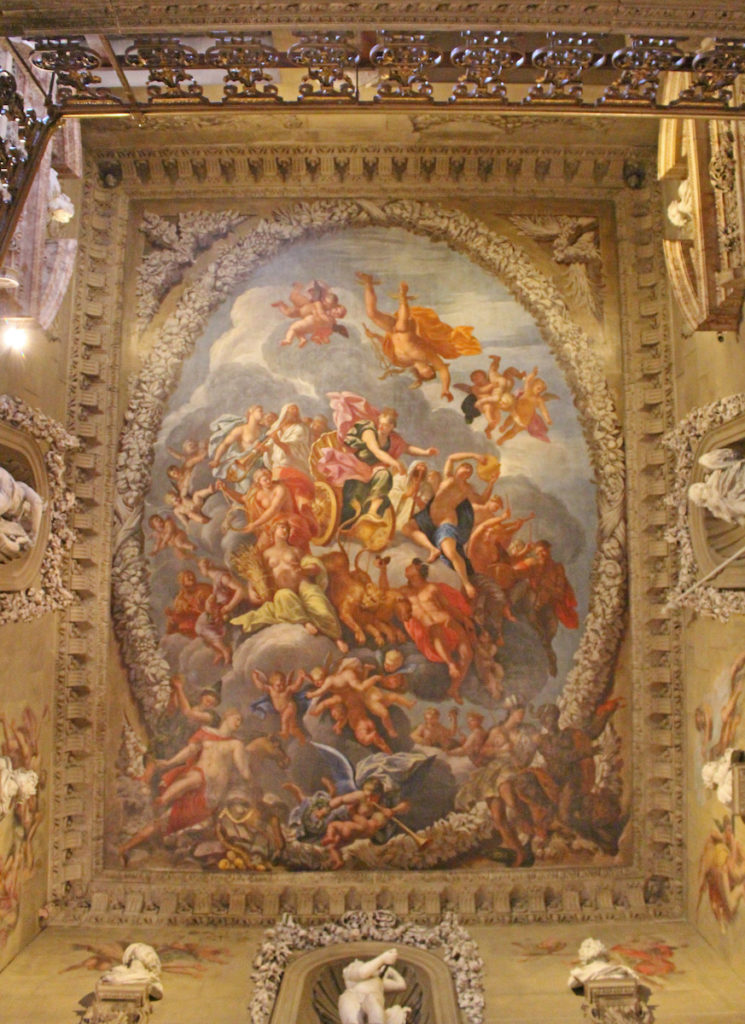
After turning from Caesar’s demise, the visitor reaches the Great Staircase: a transitional space that shifts us from a world threatened by tyranny to a prosperous new regime. The eye is drawn upwards to the ceiling filled with a triumph of the earth goddess Cybele, painted by Antonio Verrio (Fig. 9). Green and pink draperies fluttering, the goddess charges forward on her lion-drawn chariot. She presides over global prosperity; allegorical representations of the four continents offer products from their corners of the world. Below, representations of Hercules with the severed body of the hydra and the Erymanthian boar, painted in grisaille, fill the walls—symbols of William III, who use the brawny demigod as his emblem (Fig. 10).[12] While Hercules alludes to the king’s heroic efforts to depose a tyrant, above, the prosperous reign of a queen over the continents celebrates Mary II. Mary, the eldest daughter of James II, helped to legitimize the British rule of her husband William, and thus was a key component to the success of the Glorious Revolution. In the state rooms beyond, this emphasis continues to unfold, reinforcing the interpretation of Cybele as a symbol of Queen Mary.
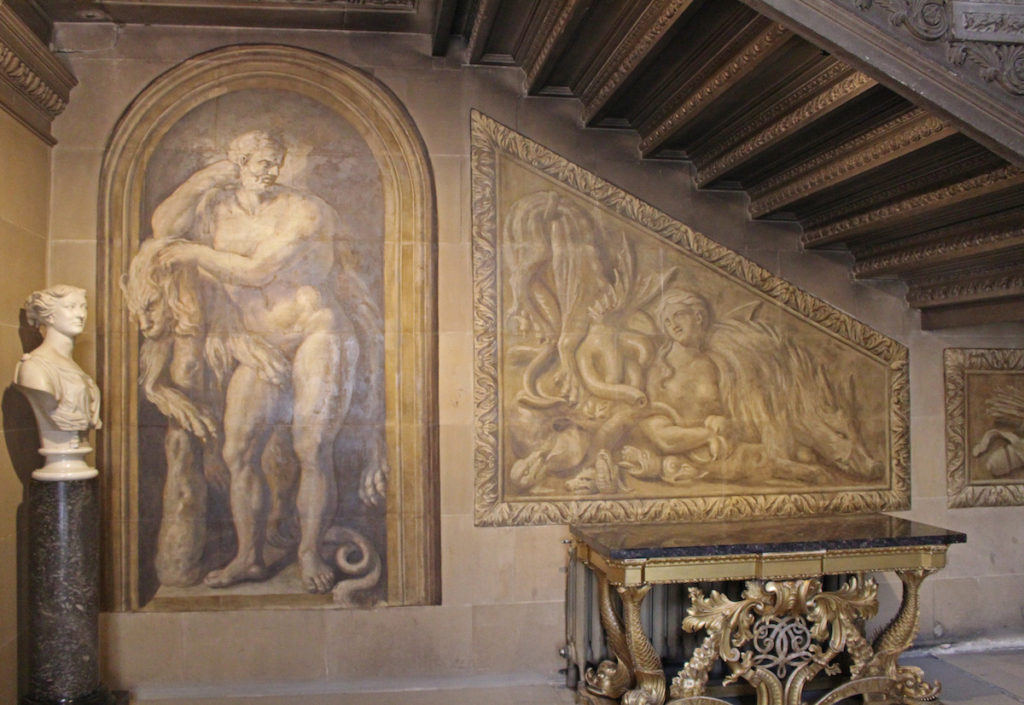
The Painted Hall and the Grand Staircase serve as introductory spaces on a route through the house to the Great Chamber, the first room in the State Apartment. In British country houses, “state apartments” typically refer to a suite of rooms intended not for the owner of the house, but rather as a space to host a visiting monarch or other elite guest. In the absence of an exalted guest, these rooms served as showpieces, designed to impress visitors with the owner’s wealth and taste. Architecturally, these apartments have their origin in continental royal palaces, as the set of rooms where monarchs would conduct the life of the court.[13] While continental palaces often had two sets of mirroring apartments, Chatsworth’s footprint only had space for one. Even so, the inclusion of a suite of State Rooms indicated Devonshire’s political and aesthetic ambitions—ambitions proclaimed by the lavishly decorated Great Chamber.[14]
When the inveterate country house visitor Celia Fiennes traveled to Chatsworth in 1697, she was struck by the “visto” that she encountered upon entering the Great Chamber, with the “very curious carving over and round the Chimney pieces and round the Looking-glasses” and the mural “painted very finely on the top.”[15] Such splendor would have prompted movement around the room, simultaneously encouraging any visitor to take in the ceiling from different vantage points to observe the salient iconographical elements.
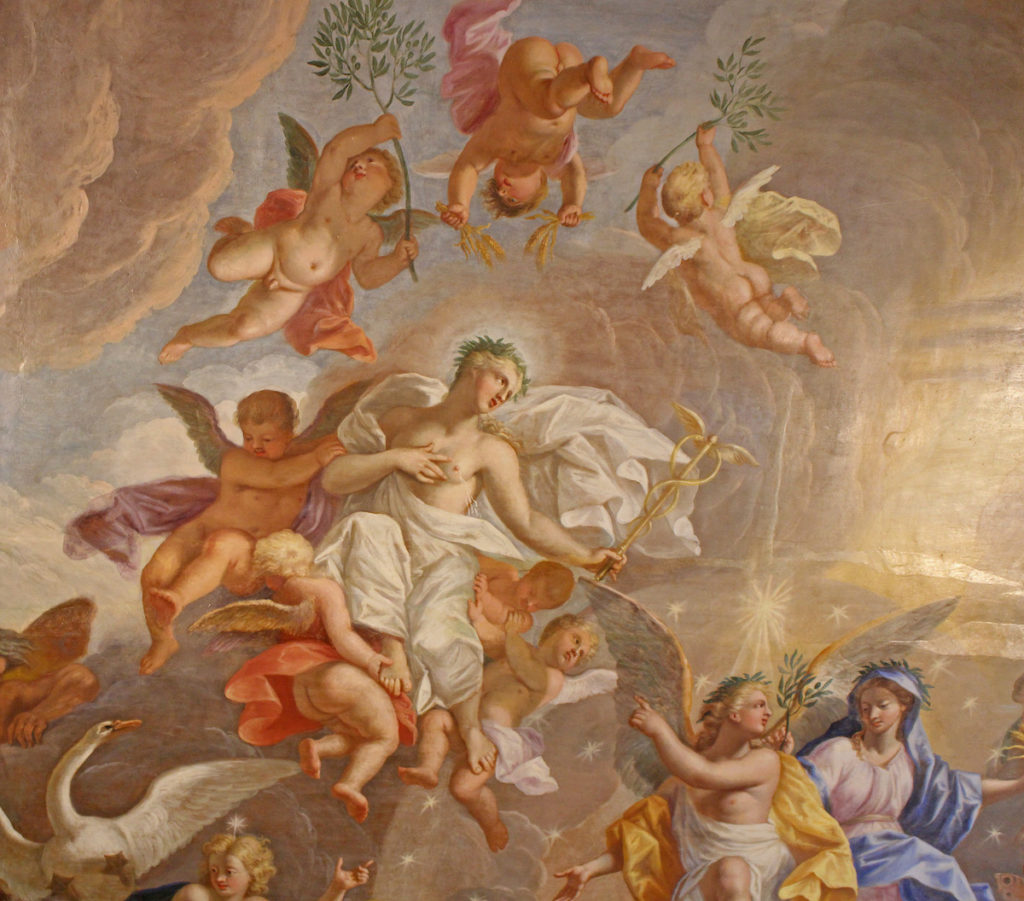
Amidst the dozens of allegorical figures, several along the central axis are key to the narrative. Close to the top of the composition, Virgo, draped in white, is borne aloft by putti (Fig. 11). Emblems make her identity clear: in one hand she holds a caduceus; with the other she expresses milk from her breast. Just below, we key on to Cybele in her lion-drawn chariot, familiar from the Great Staircase. The bearded figure of Time carries nude Truth, bringing her to light and fleeing the chaotic tangle of bodies below. At the base (Fig. 4), the blind figure of Fury wears a red cloak, his appearance corresponding to Cesare Ripa’s description of “a Man shewing Madness in his Looks, his Eyes tied with a Fillet, in a Posture as if he had a Mind to throw a Bundle of Arms bound up, in a short Habit.”[16]
The presence of Virgo is the key to interpreting the ceiling’s subject.[17] The Golden Age was the first of the four ages of man, most famously described at the beginning of Ovid’s Metamorphoses. Associated with abundance, plenty, and absence from labor and strife, it was a time when
The bearded Blade upsprung from Earth untill’d,
And loaded unrenew’d the hoary Field.
Floods were with Milk, and Floods with Nectar fill’d
And Honey from the sweating Oak distill’d.[18]
During this age, “Truth, and Innocence together reign’d,” and “all were govern’d by unwritten Law.” As the ages progressed, man became less just and more wicked, reaching the nadir in the Iron Age when, Justice—the goddess Astraea—fled, assuming her constellation form as Virgo. On Chatsworth’s ceiling, cornucopias, the flow of milk, and sheaves of wheat suggest the abundance brought about by Astraea/Virgo’s return. The prosperity of this moment even seems to spill into the real world below, thanks to the limewood carvings adorning the walls.
The subject of the Return of the Golden Age, with its emphasis on restored fruitfulness and bounty, was a favorite in courtly settings, and Astraea, the goddess of Justice, typically played a key role in its representation. Elizabeth I had frequently been compared to the virgin Astraea, poets likening the queen’s restoration of the Protestant religion to a restored Golden Age.[19] One hundred years later, Charles II used the subject as a political expression of his own return to power; in his bedchamber at Whitehall, Astraea Returns to Earth, painted on the ceiling by John Michael Wright, depicted a portrait of the king hailed by the goddess of Justice (Nottingham Castle Museum and Art Gallery).Yet, on the ceiling of Chatsworth’s Great Chamber, Verrio has inserted Astraea’s constellation form of Virgo to preside over the prosperous new era—particularly fitting, perhaps, for an aerial representation.
The Return of the Golden Age was one of the allegories used to celebrate the arrival of William and Mary. The poet Matthew Prior used this subject as a tribute to the monarchs in his Pindaric ode written for the King’s birthday in 1690:
Whilst WILLIAM, and whilst MARY Reign.
Astrea has forsook the Stars,
And joyned her Throne to Theirs,
Nor shall return from Earth again,
Whilst WILLIAM, and whilst MARY Reign.[20]
Justice and prosperity flourish under the joint monarchs. Similarly, within Devonshire’s political palace, following the dark critique of tyranny in the Painted Hall, Verrio’s ceiling offers up an optimistic vision of a new regime. Two medals spilling from the cornucopia held by Liberality may even make direct reference to the two monarchs (Fig. 12). Numerous medals were struck of William and Mary—both singly and together—following their coronation in 1689 and throughout their reign (see, for example, Figs. 14, 16), and Verrio might have used such medals as models for his representation. Their presence is thus embedded within the very wealth enshrined by the scheme.
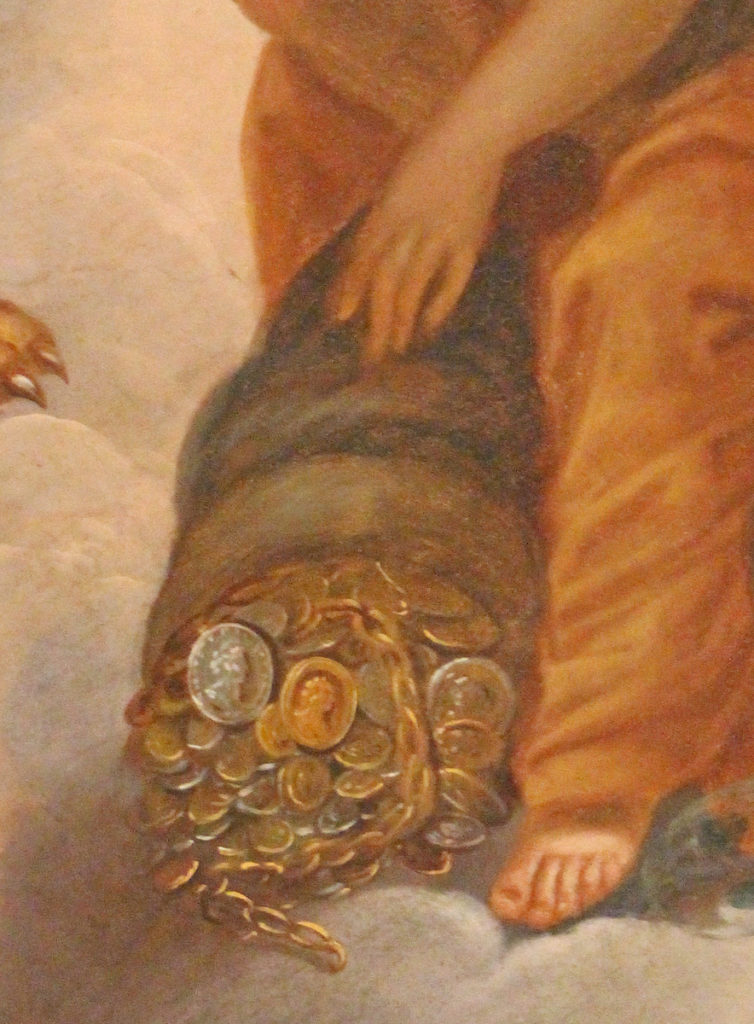
While the medals signal the presence of both monarchs, in this ceiling it is, I argue, Queen Mary who receives pride of place through the representation and positioning of Cybele. Today, structural issues with the flooring typically prevent visitors from standing at the center of the room. However, from that vantage point, the Earth goddess appears correctly foreshortened and the tangle of bodies at the base of the composition appears to tumble from the sky (Fig. 1). She flies through the sky in her chariot, dividing the vices on one side and virtues of faith and religion on the other. The visually convoluted ceiling mural resolves around this representation of a queen.
Verrio, trained in the tradition of Italian baroque mural painting, would have carefully considered the placement of figures in order to convey meaning. Born ca. 1636 in either Lecce or Naples, he began his career in Lecce before moving to Naples in 1661. He likely worked elsewhere throughout Italy, such as in Florence and Rome, where he would have been exposed to the practice of baroque mural painting epitomized by artists like Pietro da Cortona.[21] Undoubtedly he would have studied a broad range of decorative painting as he made his way northward. By the mid-1660s, he had moved to Toulouse and in 1670 he was in Paris. Thus, by the time he painted the Great Chamber ceiling at Chatsworth, he was in his mid-fifties, having worked in a variety of spaces and settings to create meaning for a range of royal and aristocratic patrons.
In representations of the Return of the Golden Age, Cybele typically serves as a stand-in for the Earth to which the goddess Astraea returns. Here, however, she is the central protagonist. She traverses the sky between virtues and vices, looking up to the arriving Virgo and the sun-filled heavens. A thin bolt of lightning emerges from behind Cybele’s chariot and zigzags towards the mass of falling bodies, as if the casting out of this group originates with the goddess. Cybele catalyzes this returned Golden Age.
Cybele is more than a generalized representation of a queen; the goddess’s traits closely aligned with the public perception of Queen Mary II during her reign. In the eighteenth century, Cybele was described as “Magna Mater, Mater Deorum, Pasithea, the Great Mother, and Mother of all the Gods; as she represented the Earth.”[22] In portraits made throughout her life Mary was associated with fecundity, the visual imagery expressing the hopes that she would produce a Protestant heir.[23] As Melinda S. Zook has recently demonstrated, Queen Mary was closely associated with motherhood, despite her childlessness.[24] For example, in the numerous sermons given in her honor following her death, Mary was referred to as a “nursing mother,” not only in England but also in Ireland and the American colonies. The Puritan Cotton Mather extolled her maternal virtues: “How many thousands of refugees found her a liberal mother unto them all; and this, without any regard unto their different persuasions…”[25] The all-encompassing attitude described by Mather referred to Mary’s inclusive views toward a wide spectrum of the Protestant faith, Anglicans and Dissenters alike. For the Protestant Devonshire, seeking a mother figure to represent a royal rather than a heavenly Mary, Cybele served as an effective stand-in.
Flattering a Pious Queen
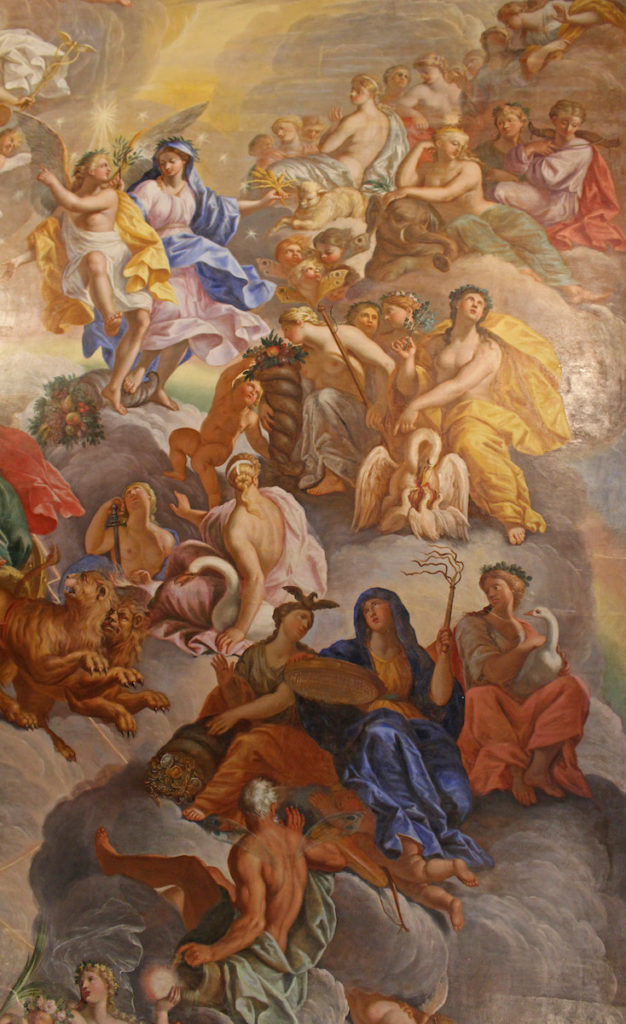
The imagery of Faith dominates the returning Golden Age on the ceiling of the Great Chamber. On the right side (Fig. 13), figures such as Patience with her yoke, Religion with her Elephant, and Compassion with her Pelican rest in the clouds. Liberality, crowned by an eagle, sits beside Chastity who holds a sieve in one hand and a cat-of-nine tails in the other. The seven Christian virtues with their identifying attributes gather on the clouds below. In contrast, Cybele’s gesturing hands reject vices such as Ignorance marked by ass’s ears, Inconstancy holding the waxing and waning moon, and the slumbering Sloth, banishing them to the dark clouds. Christian virtues and faith prevail in the Golden Age.
The triumph of good is made all the more apparent through the demise of the figures at the bottom of the composition. Cybele’s red cloak visually links with the red drapery lightly clothing Fury, setting up the two figures as counterparts in the scheme. Fury appears in the midst of blind destruction, standing upon the symbols of religion and absolutist rule. Underneath his right foot lies a crozier and a golden miter with its lappets falling over the edge of the balustrade. With his left foot, Fury tramples the Latin Bible—“DEUS” prominently inscribed at the top of the page. The jeweled crown and the scepter topped with a fleur-de-lys connect these religious symbols to the French monarchy.
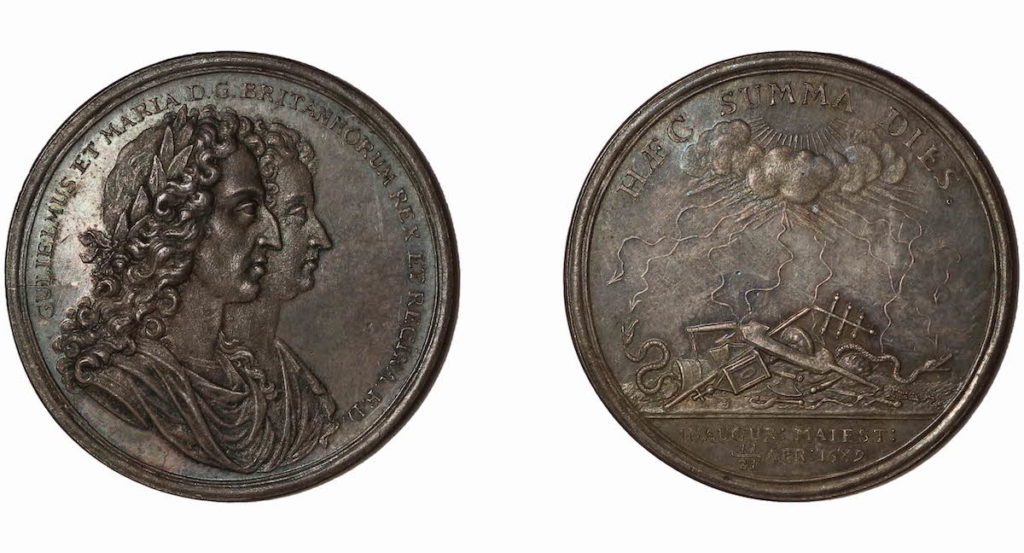
This startling vignette representing the destruction of apparently Catholic symbols makes pointed reference to the contemporary events of the Revolution of 1688. The iconography of the destruction of the Catholic symbols on the Great Chamber’s ceiling corresponds to other celebrations of the Glorious Revolution. The reverse of a silver medal struck in honor of William and Mary’s coronation depicts the destruction of papal emblems, struck down by curving bolts of lightning (Fig. 14). For many Whigs like Devonshire, tyranny and the Catholic church were closely linked. When Devonshire gave a speech to raise troops in Nottingham in 1688, he associated the fear of an “arbitrary and tyrannical government” with its “jesuitical councils” to a “condition of Popery and Slavery.”[26] On the ceiling of an important room in his country estate, he chose not simply a generalized celebration of the victory of virtue over vice, but rather hailed the triumph of Protestantism at the close of the seventeenth century. Since Verrio himself was Catholic, the duke almost certainly initiated and directed the scheme’s strong anti-Catholic sentiment.[27]
Yet, for visitors in the 1690s, the golden bishop’s miter may have signaled an even more contemporary debate. Significant tensions arose in the Church of England due to the politics of the Revolution of 1688, increasing the rift between “High Church” and “Low Church” Anglicans. The interpretation of the belief in the divine right of kings was a key point of contention. Some bishops and clergy who had taken an oath to James II felt that since he was still living, they could not then take an oath to a new monarch. Tories often aligned with these non-juring clergy and their High Church beliefs, as they sought to follow historical precedents. By contrast, Whigs—frequently more tolerant of wider ranging Protestant beliefs—understood that their “government [was] sanctioned by God, but operated by human agency in the interests of the society it governed.”[28] The bishop’s miter, while suggestive of the opulent trappings of Catholicism, could then also represent the ritual and authority vested in the bishops and the established Church. Devonshire promotes Whiggish Low Church beliefs through this ceiling vignette, a move perhaps calculated to appeal to the Queen.
While the Protestantism of both William and Mary appealed to revolutionaries, during the years of their joint reign, Mary predominantly shaped the development of the Church of England.[29] Indeed, Pincus has described Queen Mary as “the most important ecclesiastical patron in the immediate aftermath of the revolution.”[30] Raised a devout Anglican, she was a student of the Protestant faith and, following her marriage to William at age fifteen, she surrounded herself with diverse Protestant clergy. In the Netherlands, she attended services in a range of churches: Anglican, Huguenot, and Presbyterian among them.[31] Her commitment to her church was evidently much stronger than her devotion to her Catholic father, as she helped her husband oust James from the throne in 1688. Upon becoming queen she sought to reform the Church of England, dismayed by the British people’s lack of faith and the treatment of nonconformists.[32] In her memoirs, she modestly claimed “the only thing of bussiness [sic] I concerned myself in, was the filling the Bishoppricks.”[33] Indeed, during her five-year reign, twenty-five of the twenty-seven bishops in England and Wales gained their appointment. These were “Low Church” leaders who shared her tolerant views toward Dissenters. A triumph of faith thus befits an allegory for a devout queen.
Devonshire lauded the queen’s role in bringing about a new political regime. Upon her death in 1694, he wrote:
LONG our divided state
Hung in the balance of a doubtful fate,
When one bright nymph the gath’ring clouds dispell’d,
And all the griefs of Albion heal’d:
Her the united land obey’d,
No more to jealousy inclin’d,
Nor fearing pow’r with so much virtue join’d.[34]
The complete poem is replete with references to how during Mary’s reign, “Heav’n was on our side.”[35] These lines evoke a vision similar to Verrio’s ceiling, with Cybele dispelling the dark clouds.
In the early 1690s, Devonshire had reason to appeal directly to the queen. During this period, William was often away on military campaigns, and Mary ruled alone as regent in his stead.[36] Devonshire served on the cabinet council that advised her, though his influence is debatable; the queen dismissed him as “weack and obstinate, made a meer tool by party.”[37] Devonshire may have been more likely to expect a visit from Mary than from William, and, in his persistent pursuit of a dukedom, was thus eager to court her good opinion—perhaps doubly so, given her negative impressions of him.
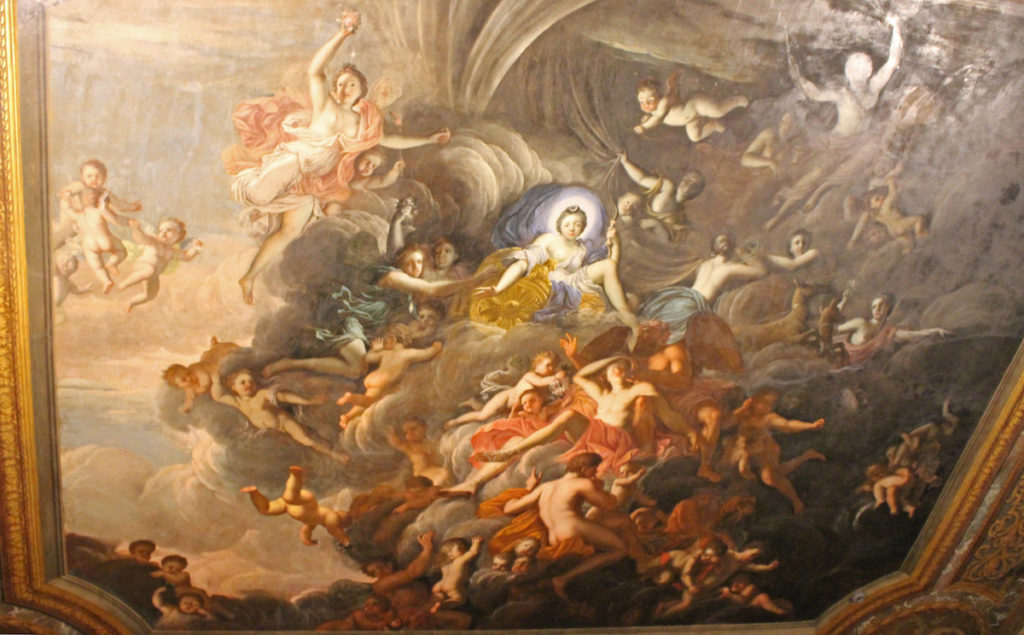
Devonshire may have even made direct reference to Mary’s regency elsewhere in the State Apartments. In Louis Laguerre’s ceiling in the State Bedroom, the goddess of the moon presides over the transition from night to day, sitting enthroned on her chariot (Fig. 15). While such imagery is common in bedchambers, Queen Mary was directly associated with Diana and her alternate epithet, Cynthia.[38] When she was Princess of York, Mary was portrayed by Sir Peter Lely in the guise of the goddess of the hunt (Royal Collection). Like her predecessor Queen Elizabeth, Mary was compared to the moon goddess, whose rays of light represented pure religion.[39] The image of the moon—a light source reflecting the sun—also seemed an appropriate emblem for the queen while William was at war. On the reverse of a medal cast in 1690 in honor of her regency, the clouds part to reveal the moon underneath the words “Ex Nocte Diem” or “Producing Day out of Night” (Fig. 16).[40] The bedchamber thus continued Devonshire’s focused political program in the State Apartments, reinforcing the centrality of the devout ruling queen.
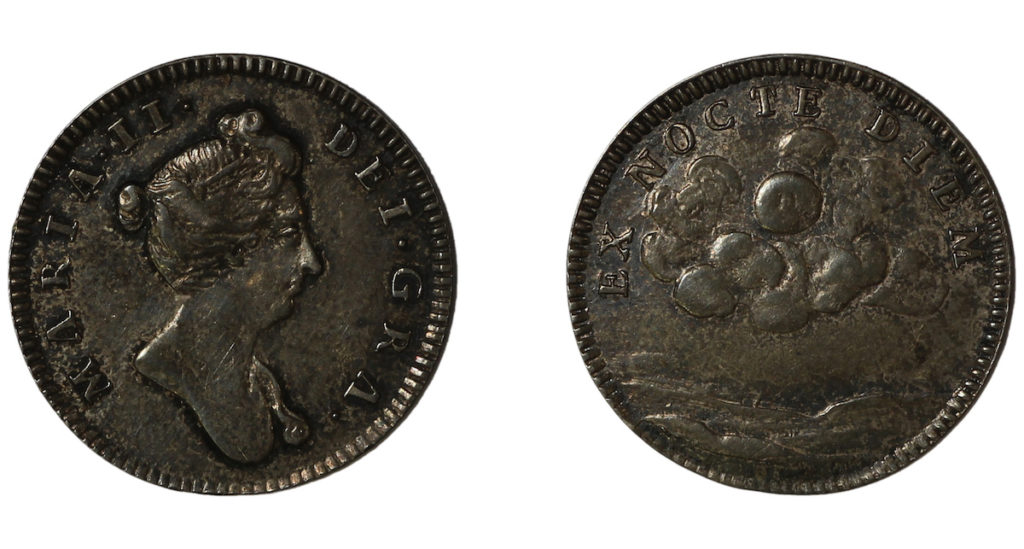
Conclusion
For audiences in the 1690s, the political statement made by allegory on the ceiling of the Great Chamber would have only been further emphasized by the style and by the choice of artist. Antonio Verrio had made his name in Britain in service to Charles II at Windsor Castle. Between ca. 1675 and 1685 he painted 22 spaces at Windsor. His elaborate murals compared the king to Apollo, Hercules, and even Christ. Verrio’s final commission from Charles II—and perhaps the grandest of the spaces—was for St. George’s Hall, decorated between 1682 and 1684.
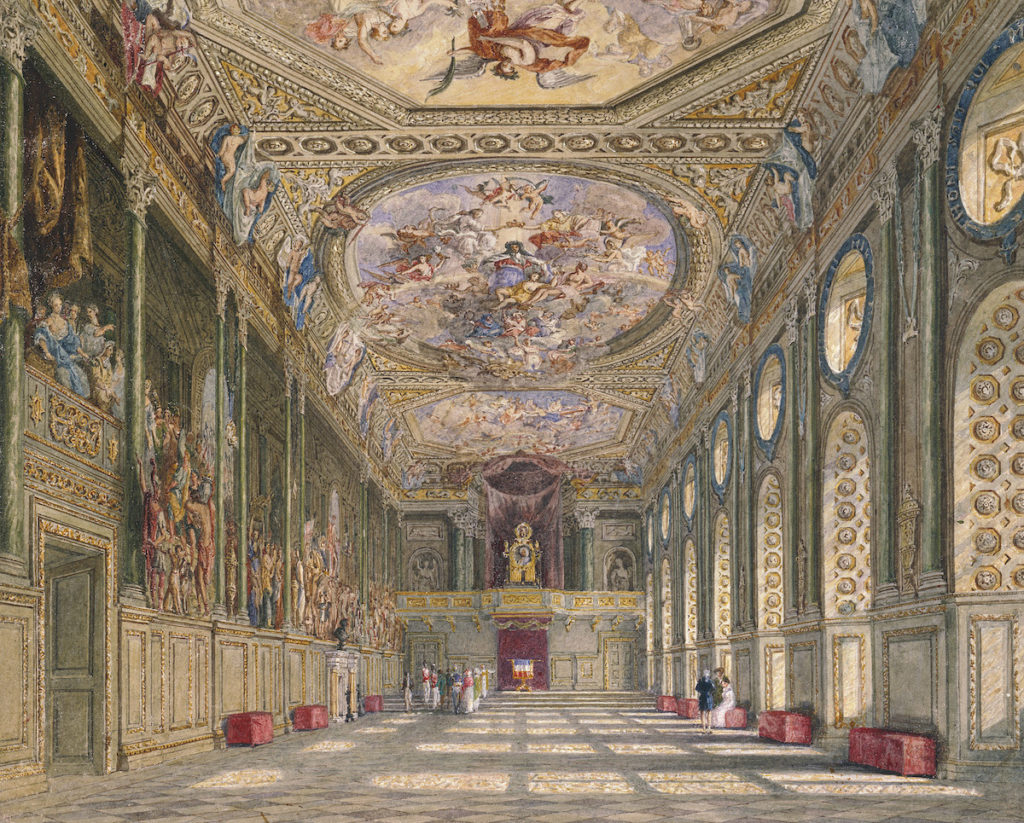
Unfortunately, as with the majority of Verrio’s ceilings at Windsor, this room was destroyed in the 1820s during the renovations undertaken by Jeffry Wyattville. However, a watercolor by Charles Wild produced before the renovations provides a sense of this ceremonial space (Fig. 17). Charles II, wearing the Order of St. George, appeared at the center of the ceiling, enthroned on a rainbow, surrounded by emblems of War, Peace, and Religion.[41] The triumph of the king and attendant virtues was dramatized by the casting out of vice. A later eighteenth-century guidebook describes “Justice, attended by Fortitude, Temperance, and Prudence, beating down Rebellion and Faction in a Hydra of evil Genii, in one of which the Painter is said to have introduced the E[arl] of Shaftesbury, a Statesman of that reign, dispersing libels.”[42] This group of tumbling bodies is visible in John Francis Rigaud’s record drawing of the ceiling (Fig. 18)—the off-kilter falling figures contrasting markedly with the scene of stability above.[43] For a king eager to celebrate and enshrine his power, such a representation proclaimed his strength and virtue.
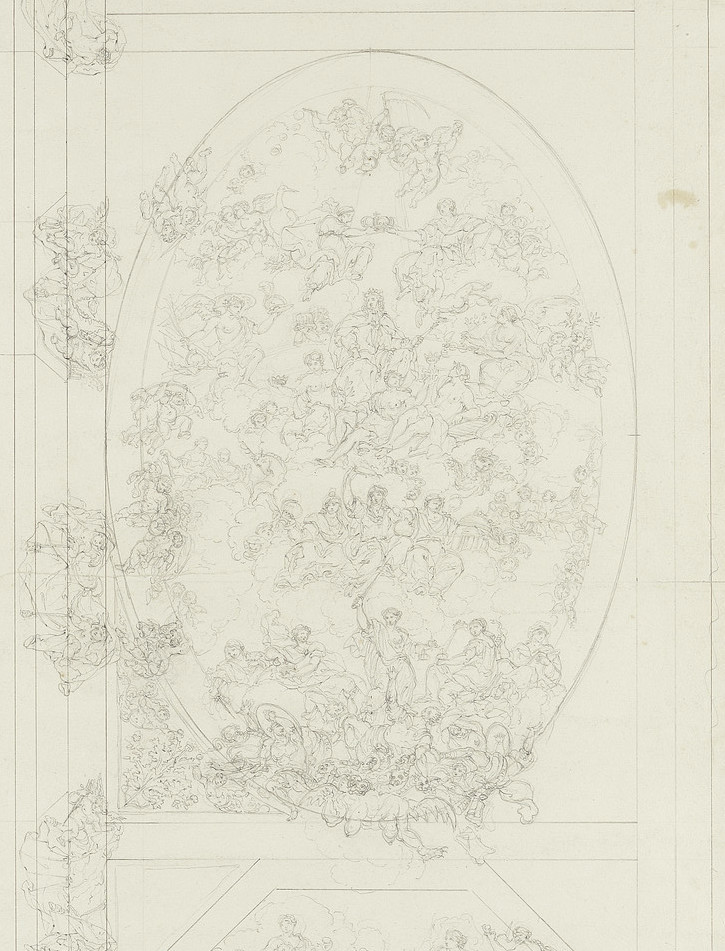
Devonshire was undoubtedly familiar with the Windsor ceilings. Thus, his decision to commission a similar scheme from Verrio based on optimistic triumph over the casting out of evil forces would have created a direct link between the two schemes recognizable to his savvy visitors. Moreover, the mural would serve not only to glorify Queen Mary II; it would also act as a reminder of Devonshire’s role in putting her and William III on the throne. The visual vocabulary that served Charles II’s regime was transformed for a new political era, in which landed oligarchs like Devonshire had increased power. With that spread of power came a redeployment of arts—a redeployment that would invigorate Britain’s visual arts as Whig landowners increasingly commissioned such works to fill their homes. A golden age of mural painting had begun.
Laurel O. Peterson is the Moore Curatorial Fellow in Drawings
and Prints at the Morgan Library & Museum
Acknowledgements: I am grateful to Tim Barringer, Edward S. Cooke, Jr., Mark Hallett, Matthew Hargraves, and Nicola Suthor for their thoughtful comments and feedback on earlier versions of this article. My thanks also go to the two anonymous readers for Journal18 whose suggestions strengthened and sharpened my argument.
[1] Lois Schwoerer discusses Mary’s unusual political position in “Images of Queen Mary,” Lois G. Schwoerer, “Images of Queen Mary II, 1689-95,” Renaissance Quarterly 42:4 (1989), 717-748, especially 725-731. For portraits of Mary, see also Catriona Murray, Imaging Stuart Family Politics: Dynastic Crisis and Continuity (Burlington: Routledge, 2016), 130-133.
[2] See Richard Johns, “James Thornhill and Decorative History Painting in England after 1688” (PhD dissertation, University of York, 2004); “‘Those Wilder Sorts of Painting’: The Painted Interior in the Age of Antonio Verrio,” in A Companion to British Art, ed. Dana Arnold and David Peters Corbett (Chichester, West Sussex: Blackwell Publishing Ltd, 2013), 77-104. Johns is currently working on a monograph on James Thornhill. See also Lydia Hamlett’s forthcoming book, Mural Painting in Britain 1630-1730: Experiencing Histories (Routledge, 2020).
[3] Steve Pincus urges caution using the term “Glorious Revolution.” At the outset, beginning as early as December 1688, the term referred to the speed and unlikelihood of the event, but it has come to imply its supposed bloodlessness and conservatism. See Pincus, England’s Glorious Revolution, 1688-1689: A Brief History with Documents (New York: Palgrave Macmillan, 2006), 4.
[4] See chapter on “Ideology of Catholic Modernity” in Steve Pincus, 1688: The First Modern Revolution (New Haven: Yale University Press, 2009), 118-142.
[5] Pincus, 1688, 3.
[6] John Summerson, “The Classical Country House in 18th-Century England,” Journal of the Royal Society of Arts 107:5036 (July 1, 1959), 542.
[7] Johns, “James Thornhill and Decorative History Painting,” 126-135.
[8] Christine Stevenson, “Making Empire Visible at the Second Royal Exchange, London” in Mark Hallett, Nigel Llewellyn, and Martin Myrone, eds., Court, Country, City: British Art and Architecture, 1660-1735 (New Haven: Paul Mellon Centre for Studies in British Art, 2016), 56.
[9] Johns, “James Thornhill and Decorative History Painting,” 130-131.
[10] Johns, “James Thornhill and Decorative History Painting,” 134.
[11] William Cavendish, first Duke of Devonshire, “The Declaration of the Earl of Devonshire, and other Nobility and Gentry assembled at Nottingham, November 22 1688,” appended to White Kennett, A Sermon Preached at the Funeral of the Right Noble William Duke of Devonshire…, 2nd ed. (London: J. Nichols, 1797).
[12] For the use at Hampton Court Palace, see Edgar Wind, “Julian the Apostate at Hampton Court,” Journal of the Warburg and Courtauld Institutes 3:1/2 (October 1, 1939), 129. See also Erik de Jong, “The Garden of Venus and Hercules: Het Loo as Political Propaganda for Stadtholder-King William III,” in Nature and Art: Dutch Garden and Landscape Architecture, 1650-1740, trans. Ann Langenakens (Philadelphia: University of Pennsylvania Press, 2000), 59-65.
[13] Katie Scott discusses this spatial arrangement, known as la distribution in France, and its implication for decoration in noble households in The Rococo Interior: Decoration and Social Spaces in Early Eighteenth-Century Paris (New Haven: Yale University Press, 1995), 101-117.
[14] Peter Thornton, Seventeenth-Century Interior Decoration in England, France, and Holland (New Haven & London: Yale University Press, 1978), 57.
[15] Celia Fiennes, The Journeys of Celia Fiennes, ed. Christopher Morris, Rev. ed., (London: Cresset Press, 1949), 99-100.
[16] Cesare Ripa, Iconologia: Or, Moral Emblems (London: Printed by B. Motte, 1709), 30.
[17] Recent Chatsworth publications have described the subject as the “Return of the Golden Age.” See Deborah Freeman-Mitford Cavendish Devonshire, Chatsworth: The House (London: F. Lincoln, 2002), 75; Hannah Obee, “The Golden Age Returns,” Apollo 167:555 (June 2008), 63. Edward Croft-Murray, however, simply describes the subject as “the Virtues and Vices and other allegorical figures” in Decorative Painting in England 1537-1837, vol. I (London: Country Life, 1962-1970), 237.
[18] Ovid, Metamorphoses, trans. Samuel Garth and John Dryden (Amsterdam, 1732; repr., New York: Garland, 1976), 7.
[19] See Frances A. Yates, “Queen Elizabeth I as Astraea,” in Astraea: The Imperial Theme in the Sixteenth Century (London & Boston: Routledge & Kegan Paul, 1975), 29-87.
[20] Matthew Prior, “A Pindarqiue on His Majesties birth-day” (London: John Amery, 1690).
[21] Cécile Brett, “Antonio Verrio (c. 1636-1707): His Career and Surviving Work,” The British Art Journal 10:3 (December 1, 2009), 4.
[22] William King, An Historical Account of the Heathen Gods and Heroes, 3rd ed. (London: Bernard Lintot, 1722), 23.
[23] Murray, Imaging Stuart Family Politics, 120-133.
[24] Melinda S. Zook, Protestantism, Politics, and Women in Britain, 1660-1714, (Basingstoke, Hampshire: Palgrave Macmillan, 2013), 155-158.
[25] Cotton Mather, Observanda: The Life and Death of the Late Q. Mary (Boston: B. Green, 1695), 40-41 as quoted in Zook, Protestantism, Politics, and Women in Britain, 157.
[26] “Declaration of the Earl of Devonshire, and other Nobility and Gentry, assembled at Nottingham, November 22, 1688.” Appendix X in Kennett, A Sermon Preached at the Funeral of the…Duke of Devonshire, 165.
[27] Employment of Roman Catholics was forbidden by the Test Act of 1673, and on November 16, 1678, Verrio was one of the first Catholic artists to receive a special warrant in order to work at Windsor Castle. Brett, “Antonio Verrio (c. 1636-1707),” 7.
[28] William Gibson, The Church of England, 1688-1832: Unity and Accord (London: Routledge, 2001), 46.
[29] See “An Incomparable Queen: Mary II and the Church of England” in Zook, Protestantism, Politics, and Women, 125-158.
[30] Pincus, 1688, 410. Mark Goldie has also drawn attention to Queen Mary’s role, “whose importance in religious history of this time has not yet been fully appreciated,” in The Church of England c.1689-c.1833: From Toleration to Tractarianism, ed. John Walsh, Colin Haydon, and Stephen Taylor (Cambridge: Cambridge University Press, 1993), 163. Tony Claydon also emphasizes the importance of the role played by Mary in relation to the bishops in William III and the Godly Revolution (Cambridge: Cambridge University Press, 1996), 70-71.
[31] Zook, Protestantism, Politics, and Women, 135-140.
[32] Zook, Protestantism, Politics, and Women, 146.
[33] Richard Doebner, ed., Memoirs of Mary, Queen of England, (1689-1693) (London: David Nutt, 1886), 37.
[34] William Cavendish, first duke of Devonshire, “On the Death of the late Queen Mary,” Appendix, No. XII in Kennett, A Sermon Preached at the Funeral of the…Duke of Devonshire, 170.
[35] More than seventy poems were published upon the death of Mary II, along with 36 funeral sermons—roughly three times the amount associated with the deaths of Charles II, William III, or Queen Anne. See Zook, Protestantism, Politics, and Women, 156-157 and Appendices A & B.
[36] In 1690, James II, supported by Louis XIV, attempted to reclaim the throne from Ireland. These battles formed a part of the larger Nine Years’ War, an effort by an alliance of European powers to limit French power and territorial expansion. For a brief discussion of Mary’s regencies, see Lois G. Schwoerer, “Images of Queen Mary II, 1689-95,” Renaissance Quarterly 42:4 (1989), 717-748.
[37] Doebner, Memoirs of Mary, Queen of England, 30.
[38] In decorating his own bedchamber at Hampton Court Palace, William III selected the subject of Diana and Endymion, likely a tribute to his deceased wife. See Edwards, “Fashioning and Furnishing for Performance,” 117-118.
[39] Schwoerer, “Images of Queen Mary,” 745.
[40] Edward Hawkins, Medallic Illustrations of the History of Great Britain and Ireland to the Death of George II, ed. Augustus Wollaston Franks and Herbert Appold Grueber, vol. I (London: British Museum, 1885), 704-705.
[41] For further discussion of this ceiling see Richard Johns, “Antonio Verrio and the Triumph of Painting at the Restoration Court,” in Court, Country, City, 169-173, as well as Katharine Gibson, “The Decoration of St. George’s Hall, Windsor, for Charles II: ‘Too Resplendent Bright for Subjects’ Eyes,’” Apollo 147:435 (May 1998), 30-40.
[42] Les Delices de Windsore; Or, A Pocket Companion to Windsor Castle (Eton: J. Pote, 1782).
[43] The dynamism of falling bodies worked well for baroque ceiling paintings and they were frequently used, as in Pietro da Cortona’s Allegory of Divine Providence and Barberini Power (1632-1639), where Minerva appears overthrowing the giants.
Cite this article as: Laurel O. Peterson, “A New Golden Age: Politics and Mural Painting at Chatsworth,” Journal18 Issue 9 Field Notes (Spring 2020), https://www.journal18.org/4775.
Licence: CC BY-NC
Journal18 is published under a Creative Commons CC BY-NC International 4.0 license. Use of any content published in Journal18 must be for non-commercial purposes and appropriate credit must be given to the author of the content. Details for appropriate citation appear above.
